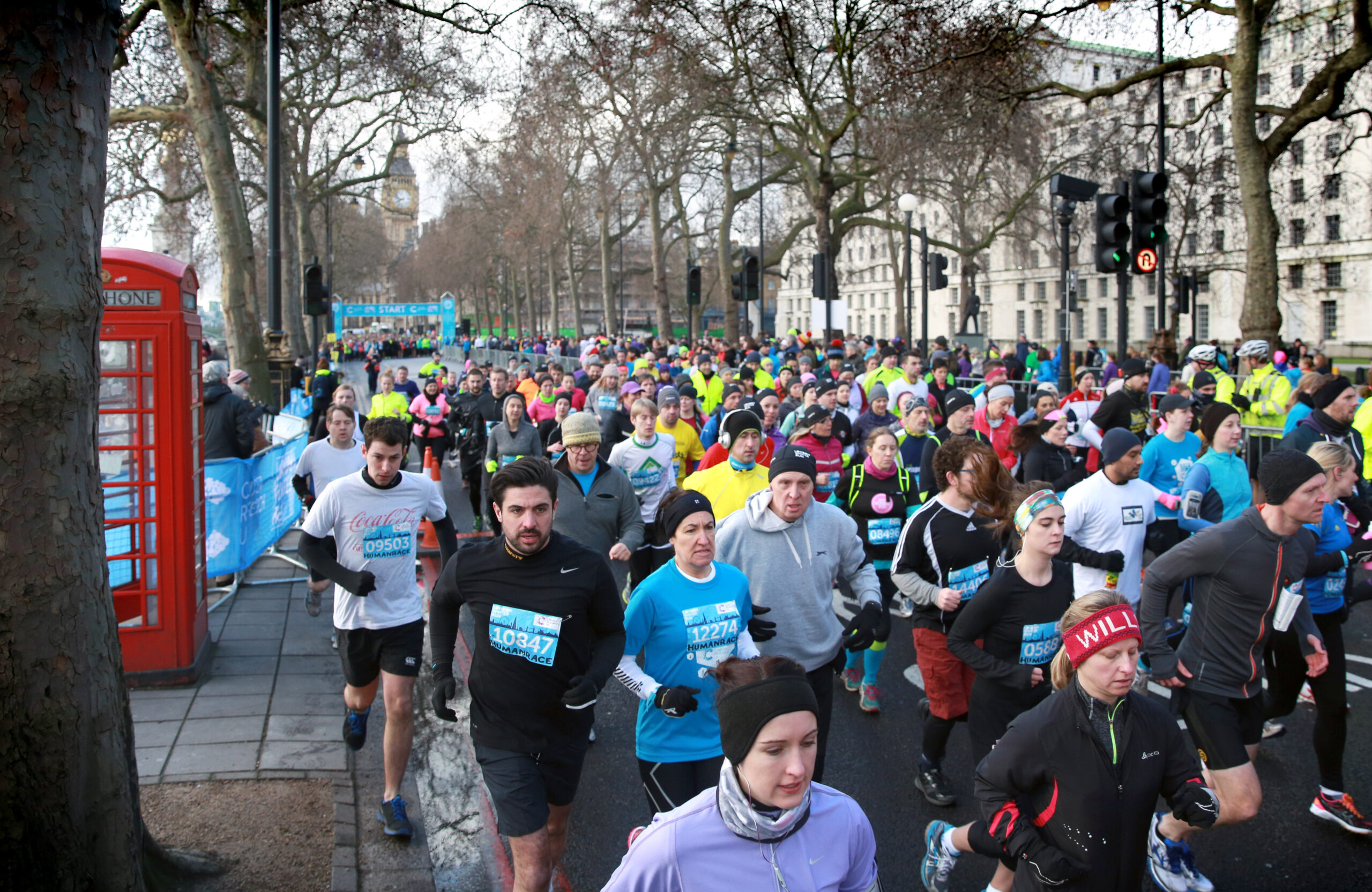FROM IDEA TO REALITY | THE STORY OF THE FIRST EVENT
Now established as the UK’s largest 10k, The Cancer Research UK London Winter Run welcomes 25,000 people annually to take part in a challenge packed full of personality. Whilst key aspects (Penguin Parties, Trafalgar Square, glorious medals, and most importantly a combined goal to beat cancer) have become synonymous with the event over the past decade, the team behind the concept faced a myriad of challenges to make their dream a reality.
A decade on from launching the Cancer Research UK London Winter Run we caught up with some of those who worked tirelessly on the first edition, who share their memories from initial ideas, through to an eventful inaugural edition.
THE IDEA
Based in the outskirts of London, event organisers Human Race (now known as A.S.O. UK) had an excellent reputation for delivering high quality triathlons, cycle sportives, and regional running events. Whilst they had organised larger scale runs, to that point they had been on behalf of other companies, so as Human Race grew ambitions turned to creating something of their own on a larger scale.
Different ideas were floated around, led by Nick Rusling who was CEO at the time:
“We desperately wanted to have a major running event in London so needed to explore what was available in the calendar and concepts that were not already taken. We started looking into the Big Gay 10k that went quite far down the line, including looking into a route through Soho and speaking to the Elton John Foundation, but that idea ran out of steam.”
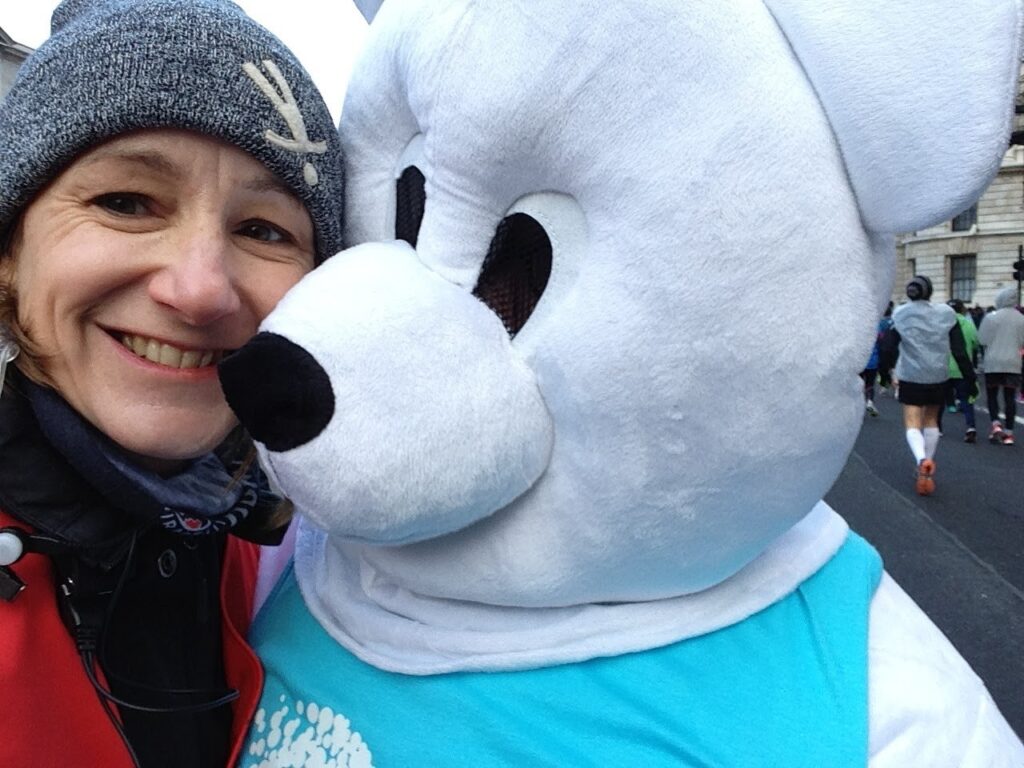
Kelsey Offord at an early event
Getting permission to hold a mass participation event is notoriously difficult, especially so in central London. It requires dozens of roads to be closed which impacts businesses, residents, and transport links. As Partnerships Director Kelsey Offord was a key part of creating new events:
“The original request that was put into the London authorities was for Human Race to stage a closed road 10k during the summer months. However, there were already a number of events that took place at that time. There was an internal discussion about whether we could make a winter 10k work and if enough people could be persuaded to leave their warm homes to do a potentially cold, wet race in London.”
Launching a new closed road run from scratch is a huge investment, and a significant gamble for a company the size of Human Race at the time. Consideration was given to whether green lighting a project taking place well outside the traditional running calendar was a wise move, but Nick Rusling had some data to back up the decision:
“We did some research with a running shoe partner around habits of runners. What stood out to me was a finding that 76% of people still ran in the winter, which gave me confidence that doing something in the winter would work.”
Justin Rees was part of the Partnerships team at Human Race:
“It took years to get the event off the ground. There were many different ideas in the planning stage, I remember concepts around a Santa Run and Christmas theming being discussed”
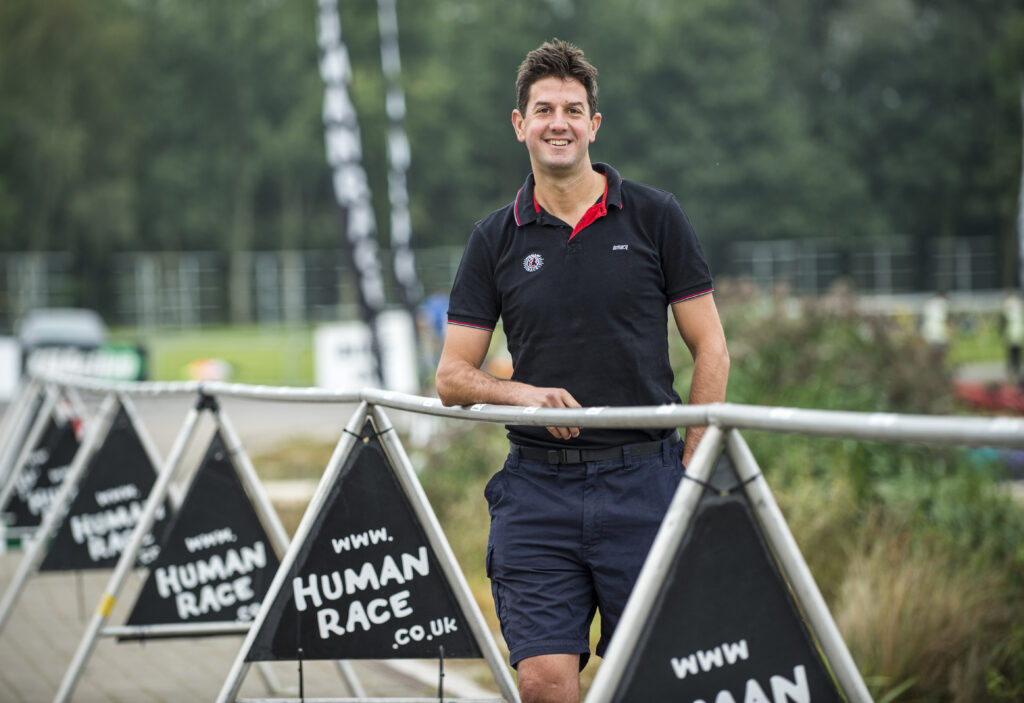
Nick Rusling during his time as Human Race CEO
The Christmas idea made some strides forward, but Nick Rusling recalls the stumbling blocks:
“We looked at doing a December event called ‘the 12ks of Christmas’ but were told by councils no chance as it’s a big time for shopping but also for pothole repairs, who knew! So, attention moved into the New Year mapping out a route that caused less disruption than existing running events, avoiding key routes like Westminster Bridge for example. Slowly but surely, we started to win over officials. We also committed to making an impact in London, including important community work. After around 18-months of working with the major stakeholders (including Transport for London, the Mayor’s Office, and various local boroughs) there was a key meeting where we needed to present for a final decision.”
Kirsty Wilde had worked on the proposals and remembers the effort to get the event approved:
“I had been working on the project since 2013, attending various meetings across London at different organisations. Cumulating in presenting at a major events oversight board meeting to the top brass at all the organisations across London at City Hall when it was based opposite the Tower of London. It was pretty nerve wracking, but we backed ourselves to have the capability of organising an event well that would be well delivered, was safe, and that delivered for London. Oh my gosh getting that first event across the line was so much work! Quite rightly the stakeholders challenged us a lot and scrutinised everything to the nth degree, and I/we set very high standards for ourselves too.”
(Instagram post showing Kirsty and team around the time of the first event)
It certainly wasn’t a sure thing as Nick recalls:
“I remember leaving not knowing how it went, but were told the next day we had got it. That was the beginning of something beautiful.”
It was around this time that the key collaboration with Cancer Research UK was agreed, which Nick thinks was crucial:
“We had great chats with good people at Cancer Research UK including Clive Saunders (Head of Events) and Claire Rowney (Director of Innovation, Campaigns & Events), who were prepared to do something different and why not!”
MAKING IT HAPPEN
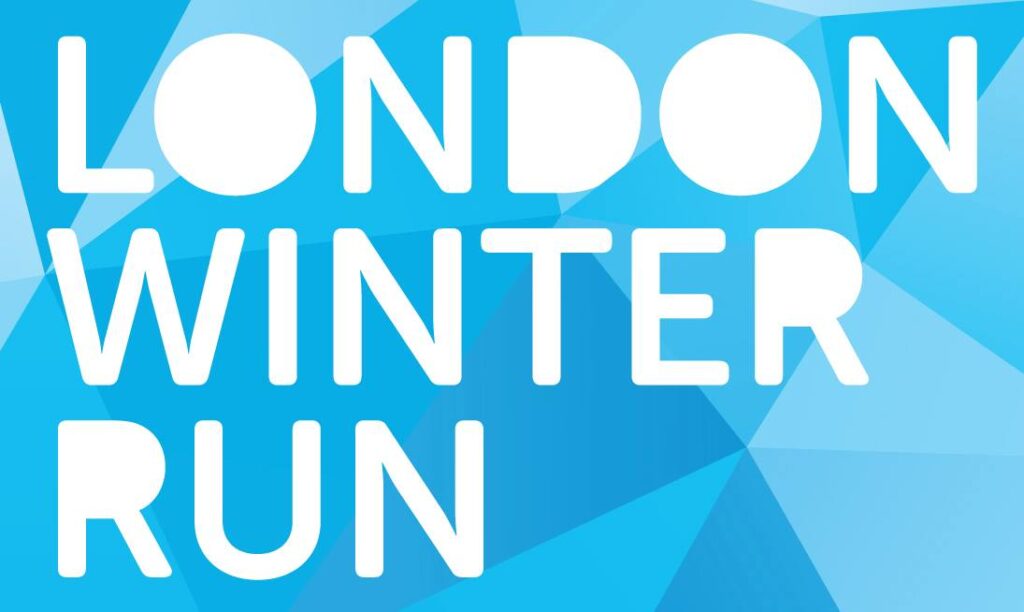
Original London Winter Run Logo
After years of planning the Cancer Research UK London Winter Run 10k was finally announced in August 2014, but the initial response was a little underwhelming. With no pictures from previous editions to bring the event to life, and just a basic logo to promote the event, capturing the public’s imagination was tough. As Marketing Director Dan Lipman was given an optimistic target to hit:
“We launched the event and ticket sales were super slow. I think we were on a few hundred at best in the August. We sat around the table in the Chessington Business Park and thought ‘how on earth are we going to get to 10,000 runners.’”
Kelsey Offord remembers trying to give the event some more character:
“It was easy to think of activations that could really bring the event to life. Snow machines, snowballs, and animal costumes associated with winter became the focus. Some of the initial ideas were not practical - ice houses and snowball tunnels were two ideas that melted away very quickly. However, polar bear hugs, snow machines and giant snowballs were all features of the first year.”
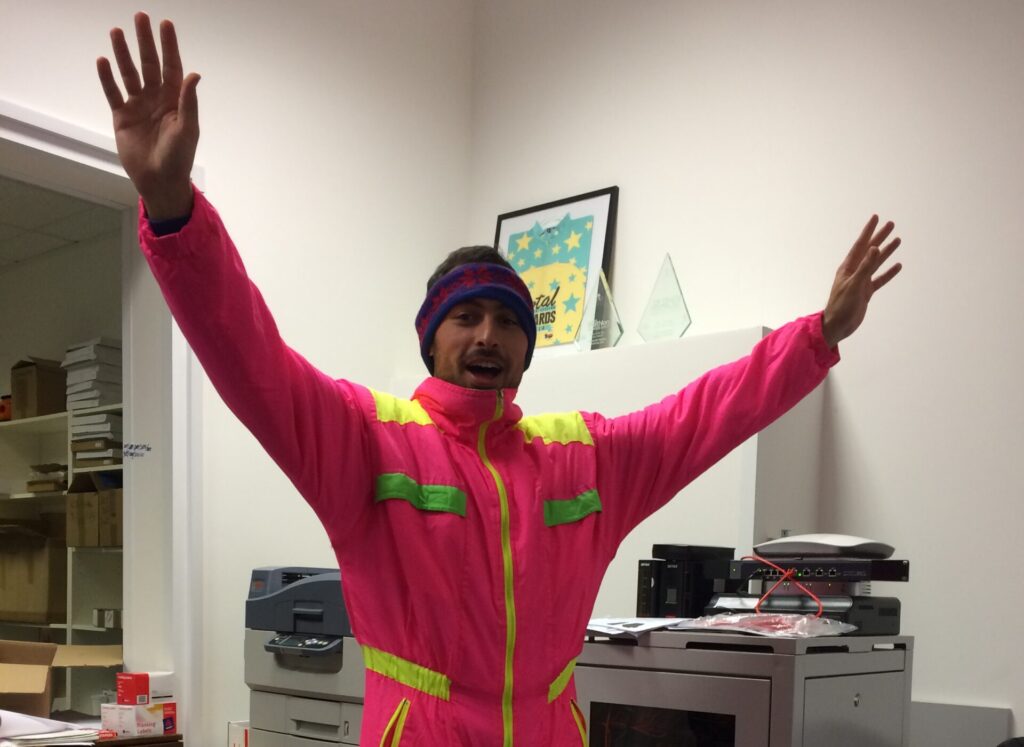
Marketing Director Dan doubled as Start MC for early events, after finding fame as an X Factor contestant.
Dan Lipman remembers coming up with concepts, and how they started to resonate:
“My claim to fame is coming up with the idea of Polar Bear hugs. We had a creative strategy session and started getting silly – ‘What if there were dancing penguins?’, ‘What if you ran through snow cannons?", or ‘What if you were hugged by a polar bear when you crossed the finish line?’. The September came and we went for it - a basic social media graphic was created, probably on Microsoft paint, and the news went out. For some reason the running community, charity community, the fitness audiences of London were just capture by the idea of hugging a polar bear at the end of the race. That month the entries for the first ever race came flooding in.”
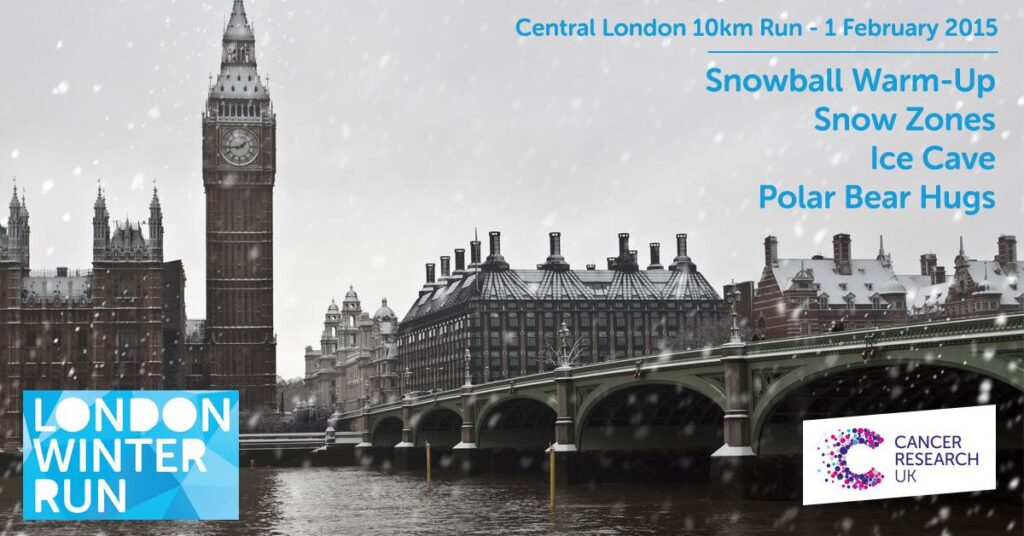
One of the first adverts people saw on social media
Nick Rusling believes those early meetings had a huge impact moving forward:
“The personality came about with the marketing need to tell different stories, excitement, experiences. That led to the majority of entrants being women, and lots of large groups. Despite being a winter event, they help it come across more friendly and warm. It’s been its successful magic dust ever since.”
The step in scale for the whole team was a challenge, but one they were fully embracing as Justin Rees remembers:
“I always remember the excitement around the office when planning the event for the first time. We’d organised countless events and had tons of experience across the industry, but this was the first time we’d done an event solely ourselves from scratch in central London. All the additional planning and processes we had to go through to get us anywhere near event day was fascinating. From the additional amounts of security scrutiny, to needing specific plans if the Queen passed given the location, all of this was new to many of us.”
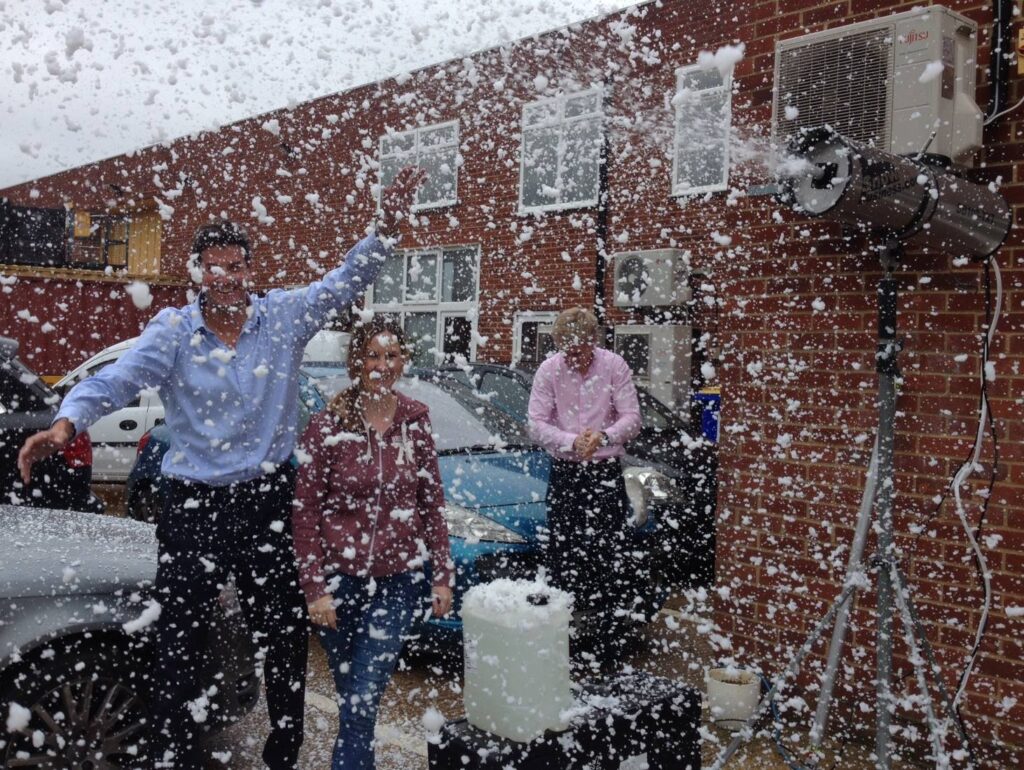
Testing the snow machines for the first time in advance of the event.
Planning was given an extra complication by the potential for arctic weather, that Nick Rusling remembers working on with Kirsty Wilde and Rob Hillman who led on the logistics for the first London Winter Run:
“Putting the event in the winter led to operational challenges, but we rose to them. The key was to ensure people were not waiting around in the cold at any point, whether that be dropping off bags or waiting in waves at the start line when they are freezing. It led to completely new ways of us delivering events. The whole participant flow was faultless because of the intention to not let people queue.”
Teams inside the company worked together to find solution to challenges as Kirsty Wilde remembers:
“I sat down with Tim who led our Customer Service team to assess how bag drop could in the limited space we had. We designed a bag drop system to keep queuing to a minimum which worked super well. Internally we called it the ‘Holdsworth’ design after him.”
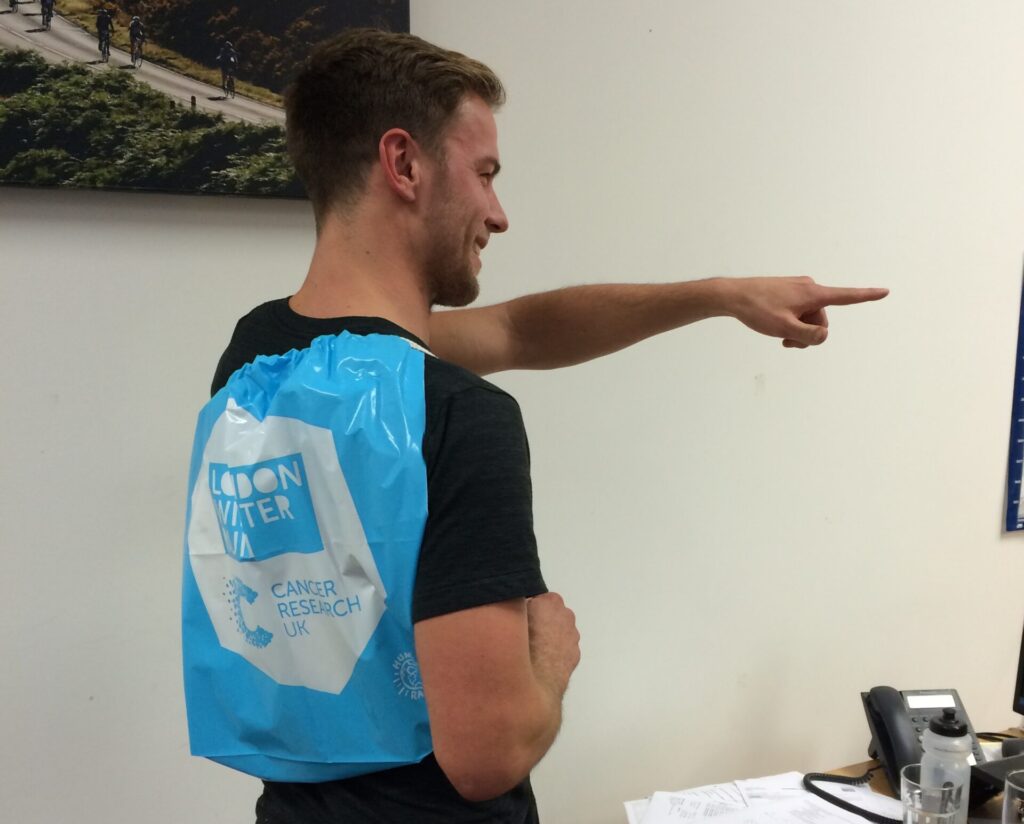
Sam Carter was one of the team used in pictures to explain how the bag drop would work.
THE FIRST EVENT DAY
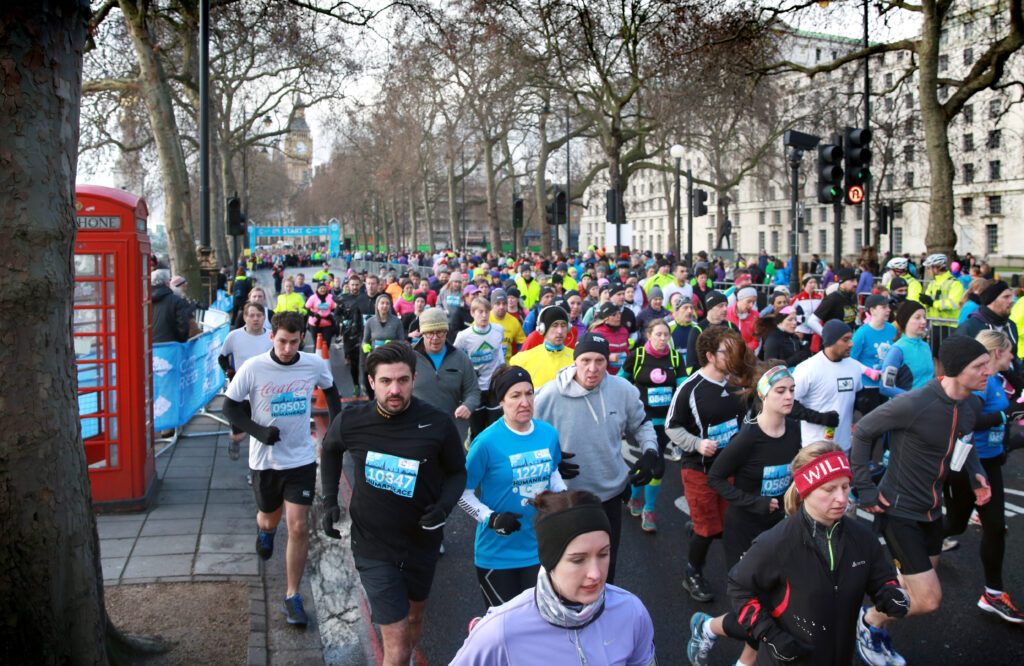
The shake-up of the event experience took a struggling Cancer Research UK London Winter Run from a few hundred early sign-ups to over 14,000 registered in time for the inaugural event day on Sunday 1 February 2015.
Kirsty Wilde was designated ‘Event Director’ and remembers the first edition well:
“My biggest and most overriding memory of the event day itself was soon after Whitehall was closed to traffic at 5:00am I took it upon myself to randomly lay down on the road - cue radio call of ‘Event Control to Event Director, we can see you on CCTV – why are you lying on the road everything ok?’, I replied ‘I’m lying here because we did it, we have closed this area of London - and because i can!’. Honestly it took so much work, so much of my time, and the age old blood, sweat, and tears to get the event organised to that point, that when that usually busy road was closed and was suddenly quiet and empty of traffic and all ours for the very first time it was such a great feeling!”
Pulling off any event of this scale is tough, but the first edition is almost the most difficult, every aspect is new and untested. The added element of winter conditions didn’t help either as Kelsey Offord recalls:
“We were on site at 3am to erect branding, however the day (night) was incredibly windy, and aside from a minus five degrees experienced at a winter trail event, this was the coldest and windiest event I've ever worked on. The wind led to a safety decision to remove all the scrim branding once it had been attached for fear that it could cause barriers to fall on participants or spectators. The snow machines we placed at the start line blew snow in completely the wrong direction, making them completely ineffective.”
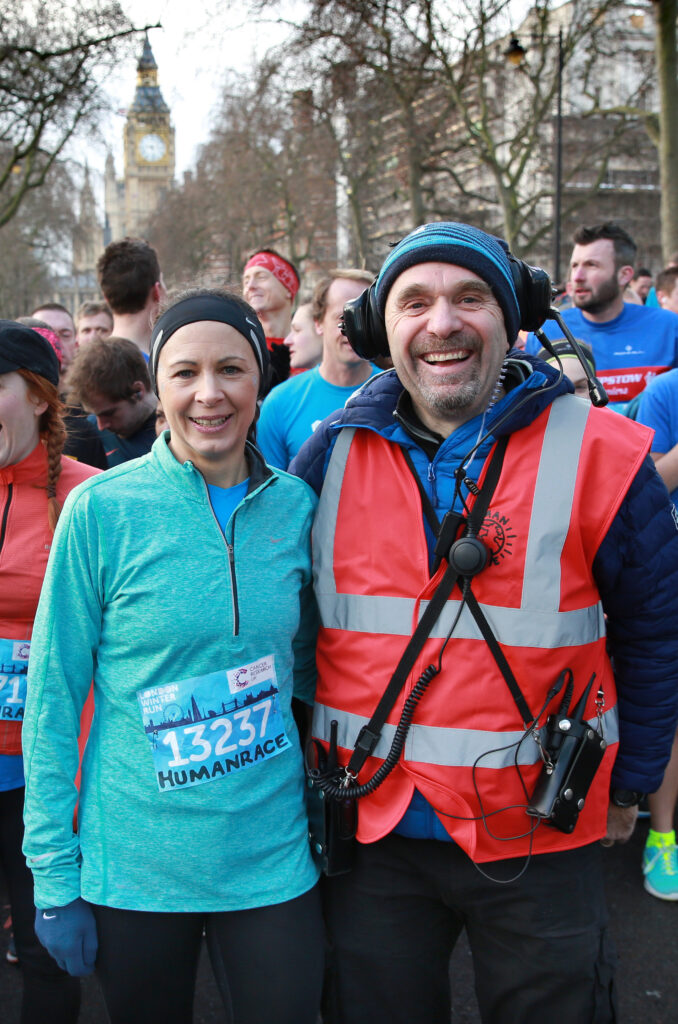
Dave Birdseye has worked every edition of the event, overseeing a smooth start process every time.
Snow machines were not the only unconventional feature of the event proving to be problematic despite good intentions:
“I recall working with Fitness First in the first year who had planned the whole warm up routine for runners on event day and helped with training plans, advice and free gym passes to help get them there. We had fun and games with a supplier trying to source giant inflatable (snow)balls to be branded Fitness First to be used in the mass warm up. These barely made it to us in time and needed a whole team of us at Fitness First in Charing Cross from silly o’clock event morning blowing them up ready for use. That type of stress but commitment to delivering something special for the runners was what drove us on, and we all put so much into making the event a success from day one. The funny thing was, we had to stop using those giant snowballs shortly into the warm-up as it became apparent they were pretty dangerous and if they hit someone who wasn’t looking it would knock them flying!”
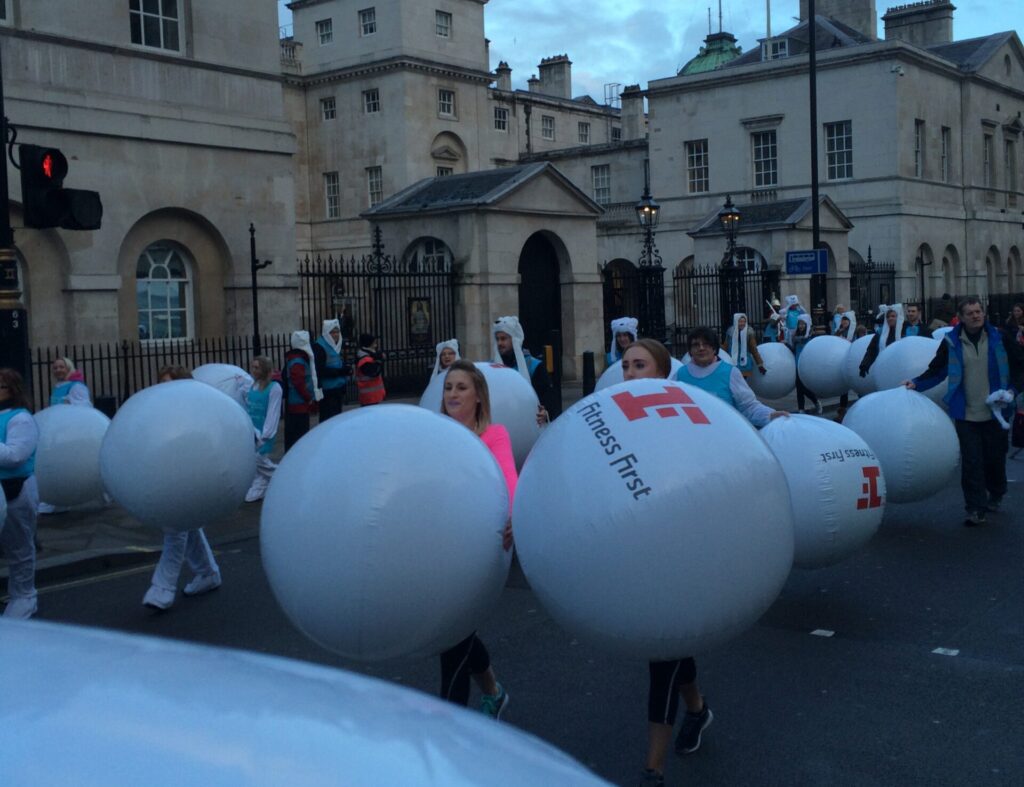
Volunteers carry the short lived giant snowballs to the start line.
The event was one of the first Chris Atkinson worked on, and the PR Executive sensed he was being kept out of the way:
“I had some basic PR tasks first thing, including walking the legend Jo Pavey to the start, but my main job was being sent to the opposite side of the river to the course by our PR Manager Gill Daly to ride the London Eye. I was booked on the first capsule of the day to take pictures from high above showing the scale of this massive 10k. A good idea in principle, but I had to use my already outdated iPhone. Not sure it garnered the results we wanted but looking across the huge crowds really hit home what we had achieved. Considering we had the Finance Director monitoring portable toilets, my day worked out a treat.”

One of the pictures of the 2015 event taken from the top of the London Eye
Others working the event found the experience just as special, including Dan Lipman:
“I have a memory of walking around the streets of London at about 4am in the morning for the first event thinking wow, we are really closing down the city I've lived in my whole life.”
For all the course planning, quirky features, and painstakingly designed medals, it quickly became apparent that the real stars of the event were the volunteers. Hundreds were recruited to perform a plethora of tasks from sorting bags, to dressing as wintery creatures.
As part of a wider project team, Sam Young helped shape their roles:
“The volunteers in the first year were magnificent! As a group they instantly bought into the event concept and completely shaped the tone and vibe of the day. I remember taking the ‘Penguin Party’ volunteers down to their area at the Bank intersection, and they were already hugging and dancing with each other. Being in their company at 6am, I knew that we were in for a special day! The costumes and accessories we provided the first year were a tad basic, but the volunteers’ energy and enthusiasm made a simple idea come to life and you couldn’t help but smile as they engaged and interacted with people tirelessly. Our runners just couldn’t get enough of it. We definitely took that experience into planning future editions.”

Some of the hundreds of volunteers who attend every edition.
Volunteers weren’t just limited to humans either as Kelsey Offord remembers:
“At the time, Human Race were partners with Switzerland and we even had two St Bernard dogs in Trafalgar Square that were greatly loved by the participants.”

Despite the challenges, the event delivery went incredibly smoothly, with the carefully designed new arrangements to prevent people waiting in the cold working a treat. Feedback from participants was overwhelmingly positive, and a return edition was quickly launched. The best news of all was that the 2015 event had raised £300,000 for the crucial work of Cancer Research UK.
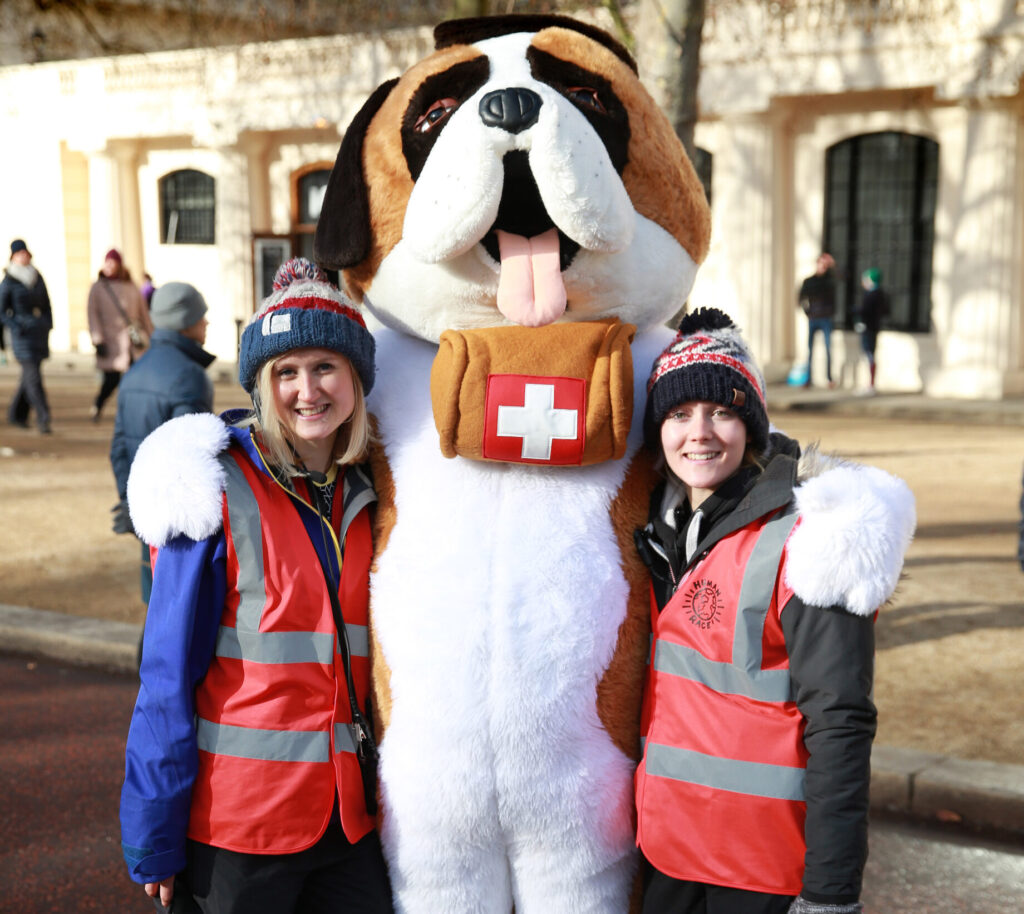
Gill & Flo, who were both part of the original team who organised the event, pose with the Swiss mascot.
LEGACY
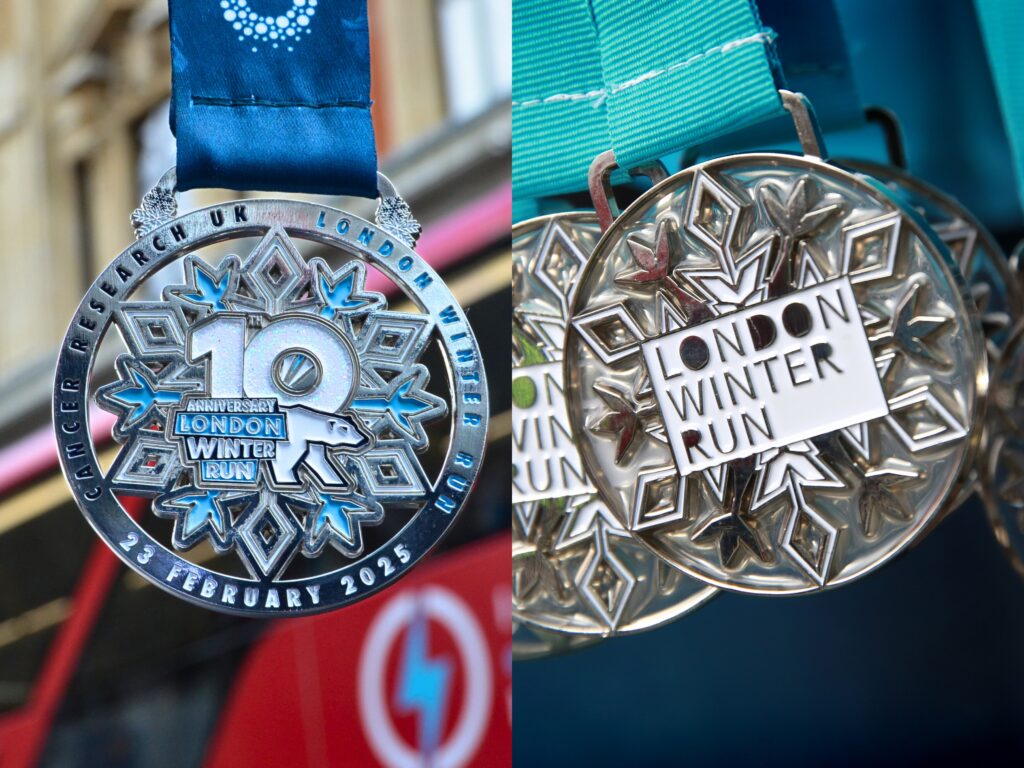
Original medal (right) with the 10th Anniversary version (left), which pays tribute to the 2015 design.
The event has evolved ever since, with hit features returning, and new ones being added every year. In the decade since the first event some of the core team have gone on to new challenges, but it’s telling that most come back annually to take on the event they helped create, this time from a different perspective. Former CEO Nick Rusling will take on the tenth anniversary edition with his family, as will Kelsey Offord:
“Since leaving Human Race, I've taken part three or four times with a big group of friends; it's become a tradition with us doing the race in the morning, then heading over to a pub near Waterloo for a roast dinner and drinks. As a regular runner, I generally just use it as a training run for another event I've signed up for, but this is the race that my friends train for every winter and building the mileage up to 10k in the winter months is always a good challenge for them.”
Many of those who have replaced them had been inspired to join thanks to taking part in the event. That includes current Partnerships Director Freya Norrie who took part in that very first edition and is leading the charge to try and hit an incredible £1,000,000 in fundraising from the tenth anniversary edition in 2025.
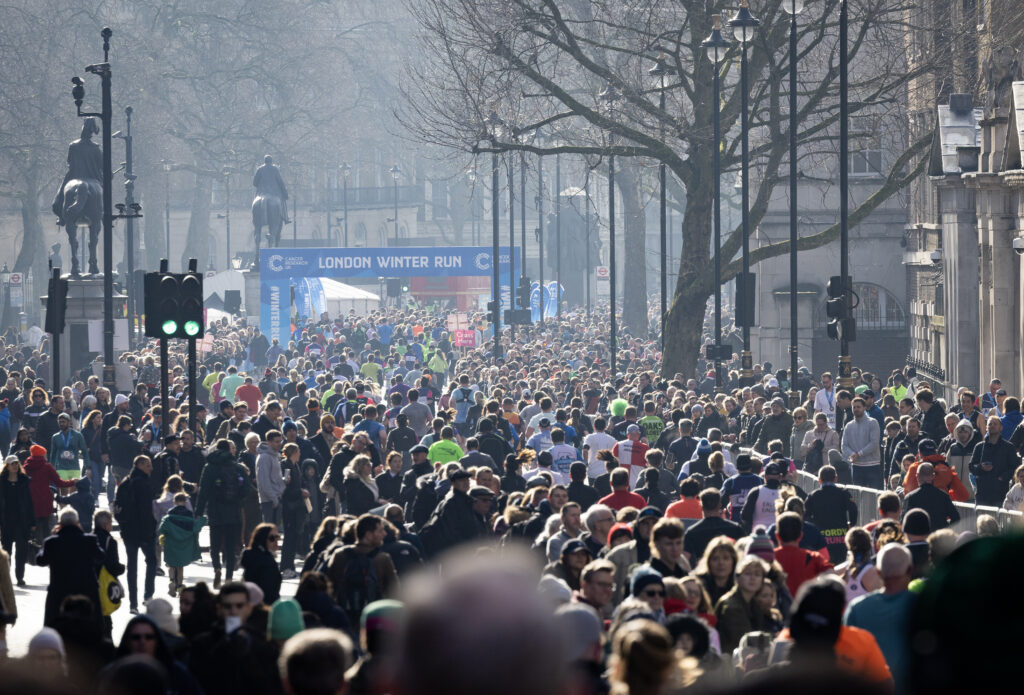
The 2024 edition, which continues to build on the success of the original concept.
Original Event Director Kirsty Wilde still oversees the event, and is rightly proud of what was achieved on the original edition:
“Whenever I see the photo from that first event of the very first wave setting of with Big Ben in the background showing exactly 09:30 on the clock it brings back the memory of how good that moment in time felt at the time and that we had done it! I am so proud of the event and how far it has come from those early conceptual meetings with stakeholders to it being the biggest 10k in UK, it’s been quite the journey over the years!”
Since launching in 2015 the annual event has raised over £6,500,000 for Cancer Research UK and attracts a sell-out audience well in advance, making it the largest 10k in Britain.



